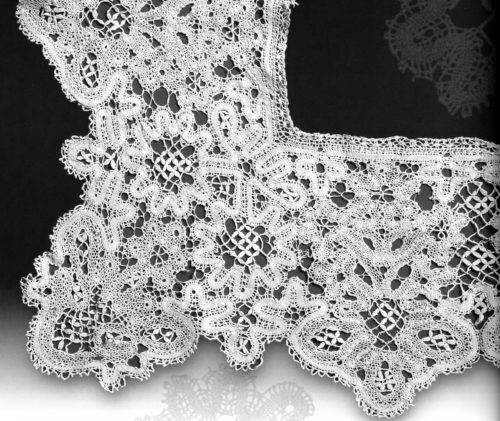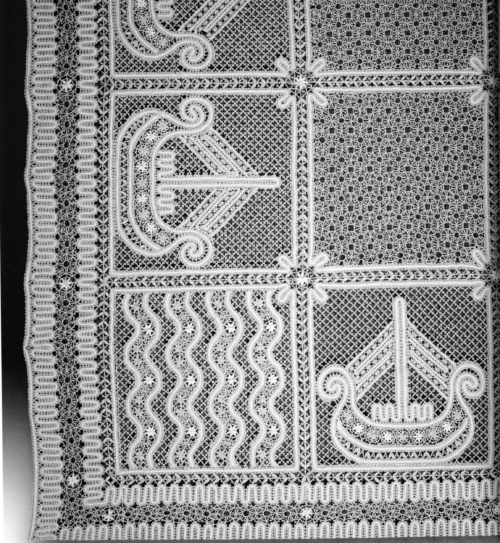
Vologda lace. Lace is one of the types of artistic textiles used to decorate clothes and interiors.
In Russia, for a long time, they love openwork needlework. Openwork products are crocheted and knitted, sewn with a needle. But it is lace that is woven on bobbins that is most artistically developed and has a wide range of methods of execution.
How Russian Vologda lace is made
The appearance of lace largely depends on the material from which it is woven: metal, gold-silver threads create the impression of solemn festivity, and white – linen or cotton – make it more strict. The thinnest, almost weightless lace can be woven from silk or linen thread, and the most massive, with large patterns – from thick paper or woolen yarn. For weaving lace, first of all, a pillow is needed – a tightly packed roller, standing in front of the craftswoman on a wooden stand (hoop).
The process of creating lace begins with making a “chip” – a drawing on paper, which is then pinned onto a pillow. In addition to the lines of the future pattern, there are many points on the chip where the pins are stuck. From the pins, threads are fanned out, wound on wooden bobbin sticks – the main working tool of the lacemaker. She quickly, with almost imperceptible movements, transfers them from one hand to another, intertwining the threads.

Lace-making in Russia in the 17th century
Having appeared in Russia in the 17th century, lace-making first developed in the workshops of the royal court, boyar svetlitsa, and monastic cells.
It was woven from metal threads and used to decorate elegant clothes, church vestments, and church decorations. These laces have come down to us in the form of stitches, edges and agramants – lace stripes with teeth on the upper and lower sides. They were used to sew clothes and hats, church vestments. They went well with brocade, velvet, silk.
The famous center of lace-making in the Tver province was the city of Kalyazin. In the middle of the 19th century, in colored silk Kalyazin lace, metal threads were used for the background gratings, they outlined the contours of the patterns. Blue and gold silk threads. In the lace ornament, bird figurines, more like flowers, attract attention. These motives, having undergone changes, were preserved in the Kalyazin lace until the beginning of the 20th century.
Where was lace produced?
Rostov Yaroslavsky was a very small center of lace-making, in 1880 only 14 lace-makers worked there. At the same time, this center made its own contribution to Russian lace: the special background pattern “Rostov’s cross”, developed by local craftswomen, began to be used almost everywhere.
Lace-makers from the town of Balakhna (Nizhny Novgorod province) also depicted double-headed eagles, alternating with birds and lush trees, on a wide lace of the first half of the 19th century. Their outlines are clear, outlined with a relief “filigree”. The figures and the surrounding background are filled with grids of different patterns. But Balakhna laces are interesting not only for their plots. Here they wove an amazingly beautiful multi-pair lace made of black and silvery silk with a lush floral ornament. The most complex patterns – garlands, curly ribbons, flowers with buds, whole bouquets – fill the background. So they wove shawls, scarves, collars, capes, whole dresses.
One of the largest lace-making centers in Russia is the town of Yelets in the Oryol province. At the end of the 19th century, a special type of lace was woven in Yelets – “Russian Valenciennes”. It was very popular in Russia and was used to decorate clothes and linen. Measured lace, scarves and kerchiefs, handkerchiefs braids were also woven. Their elegant floral patterns – roses, lilies, garlands and ribbons – are executed with great taste, subtlety and grace.
Some types of lace making, well known at the end of the 19th century, have been forgotten in our time. These include, for example, Belevskoe lace (Tula province, the city of Belev). Belevskie lace makers wove rather expensive and in constant demand things: bedspreads and pillows, kerchiefs, scarves, dresses.
Mikhailovskoe lace
However, Ryazan lace acquired the widest popularity thanks to the small town of Mikhailov.
In the 19th century, both thin linen lace of exceptionally fine weaving and wider lace lace with images of birds, two-headed eagles, lions, from colored silk and gold-silver threads were woven in Mikhailov.
Colored lace, known as “Mikhailovskoe”, received the greatest recognition. Its appearance resembles a dense colored braid with teeth – “capes”, “bells”, “small towns”.
Nowhere, except for Mikhailov, lace did not have such brilliance and originality of patterns. In the simplicity and clarity of the colored patterns, the folk taste was most fully expressed.
Mikhailovsky lace can serve as the best expression of the rich imagination and spirit of creativity that Russian peasant women fully possessed.
History of Vologda lace
The Vologda land is a famous center of culture and art of the Russian North. Among the crafts in the XIX – XX centuries, carving and painting on wood and birch bark, patterned weaving, embroidery, blackening on silver, pottery were widespread. But the Vologda lace has earned truly world fame.
From the end of the 18th century, lace craft began to develop both in Vologda itself and in the districts. The Vologda lace ornament is distinguished by its special originality. Its lines are smooth, flowing, gently curving. Even geometric patterns take on a rounded shape. The main quality of lace is openwork. Vologda lace makers have created many transparent lattices that fill the background between the figures, making the lace look like frosty patterns, an apple orchard, a flowering meadow.
The favorite material of Vologda lace-makers is flax. Linen lace is durable and beautiful. Modern lace is also woven from cotton threads, less often from silk, sometimes adding metallic threads (methanite and lurex).
In the Vologda province, both multi-pair laces and coupled laces have long been woven, and in each district the lace had its own character – the tools of lace-makers and the manner of weaving were different.
Lace craftswomen of the XX century
The lacemaker K. V. Isakova
Since 1931, K.V. Isakova, laureate of the State Prize of Russia, later director of the Vologda lace vocational school, then a school, and the author of a book on lace weaving, worked in Vologda. In many of Isakova’s works, images of northern nature have been embodied. The Northern Lights tablecloth and the Deer panel depicting graceful animals, as if frozen in the midst of fabulously beautiful and majestic fir trees, are distinguished by their warmth and sincerity.
In the 1960s – 1970s, V.D. Veselova performed a number of square panels and tablecloths, for each of which she found a figurative solution, bright and precise motives of the ornament.
The work of V. N. Elfina, Honored Artist of the Russian Federation, laureate of the State Prize of Russia, an outstanding master of modern decorative and applied art, is multifaceted. Almost each of her works is a new word in the field of floral ornament. All her life she embodied the theme of nature in lace – from romantic tulips and hyacinths to generalized images of plants in general.
The most significant work of Elfina is a round tablecloth with a diameter of 3 meters “Snowflake”, which gave the name to the Vologda lace firm. The pattern of the tablecloth is made up of snowflakes of different sizes and shapes.
Vologda lace catalog





























